Road to Paris: Fundamental, Forgotten and Useful Data on Climate Change
September 30, 2015
on
on
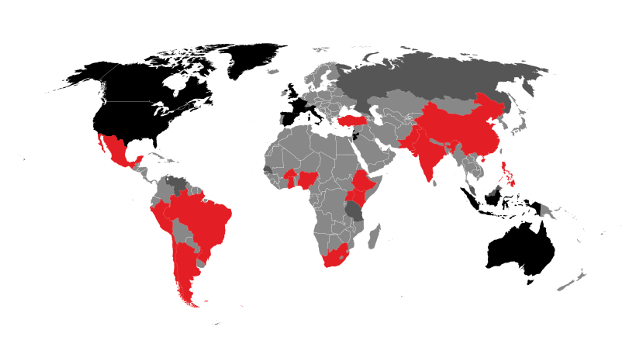
As the COP 21 in Paris approaches, this is probably one of the most fruitful moments for action against climate change, but it is not without contradictions. On the one hand, the US have signed one of the most historic deals with China for capping their emissions. On the other, two of the most prominent Republican candidates struggle to accept the issue: one, Jeb Bush, belongs to the same family who significantly contributed to the failure of the Kyoto Protocol, and recently responded to the progressive Pope Francis’ encyclical on climate change by suggesting that the Church should not interfere with environmental or political issues. The other, Donald Trump, is a declared climate change denier:
Meanwhile, climate deniers have been largely, and often secretly, funded by corporations. This is the case for Koch Industries, which are accused by Greenpeace of having spent almost $80 million on climate change denial since 1997, or Exxon Mobil, which funneled $16 million to deniers from 1998 to 2005. Similarly, media have often been criticised as biased, particularly for the disproportionate coverage of climate deniers, as in the 2014 accusations over the BBC reporting on the fifth IPCC report. An issue which the BBC itself already discussed in a 2011 report on science impartiality, which showed significant room for improvement. However, this goes in the opposite direction of the increasing scientific consensus: it was 2013 when Cook and others published a famous report which indicated a 97% consensus among scientists on the anthropogenic origin of climate change.
As the data are now more and more available, we decided then to summarise some of the most important, less heard and possibly useful pieces of evidence and facts on climate change.
Data are labelled under six mini chapters, which you can navigate by clicking on the links below.
1. Climate change evidence
2. Future impact of climate change
3. Causes and responsibility
4. Media coverage and the general public
5. National commitments and INDC
6. The future: trends and action
Source: NASA.
Temperatures have been clearly rising from 1977, but NASA data show that such a trend can be traced back even to the early 20th century. Climate scientists estimate that there is a 97% likelihood that 2015 will be the hottest year since records began in 1880, followed by 2014 and 2010, second and third. The ten warmest years have happened in the past 17 years, 9 of them in the 21st century.
This is not without consequences: higher temperatures are responsible for the fast decrease of the Arctic sea ice, which has been recorded since 1981, for the sea level rise and for the increased weather variability. Indeed, precipitation and heat extremes have significantly increased from pre-industrial age averages, up to five times. One of the most visible effects of climate change is, however, wildfires: compared to 35 years ago, higher temperatures and variable rain seasons have made forests more arid and more vulnerable, extending the average wildfire seasons in the US by more than a month. The dramatic California fires highlight the exposure of the USA, but this is global phenomenon which largely affects Asia and the Mediterranean, among the others.
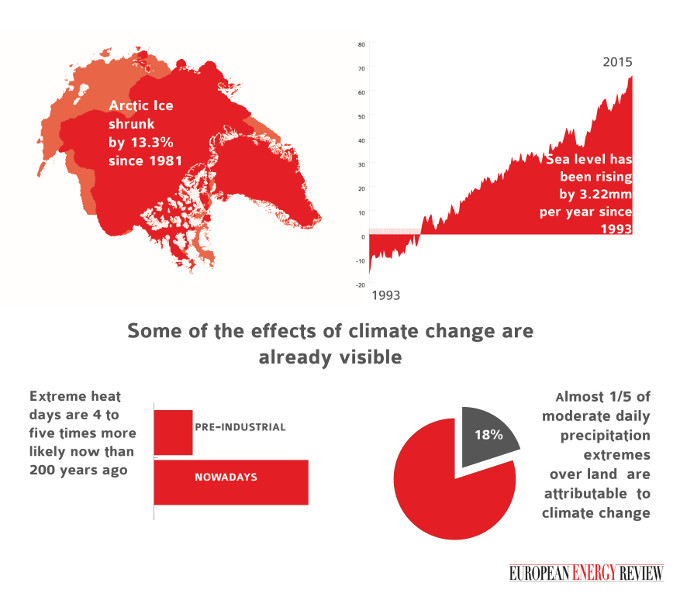
Source: NASA and Fischer and Knutti.
Source: The Economist, the Lancet and the Stern Review.
The economic impact of climate change is still hard to define exactly, due to the uncertainty and the extent of such an unprecedented phenomenon, but even the most cautious estimates are alarming. In 2006, the “Stern Review on the Economics of Climate Change” was one of the first, and probably the most ambitious report trying to assess the economic costs of a 5-6 degrees temperature rise. Since then, several reports have tried to go deeper into the threats to specific sectors, as in the case of “The Cost of the Inaction”, by the Economist Intelligence Unit. Under the report’s assumptions, a 6C increase could lead the world to lose one third of its entire stock of manageable assets. If direct damages will have mostly a local effect, indirect impacts will greatly endanger the global economy.
Climate change will not affect every country in the same way: one of the reasons why “climate change” is probably a more accurate expression than “global warming” is that the temperature will not increase globally in the same way, and that what we have to fear the most is the variability of weather. Considering also geographical differences, climate change will have different effects in each continent and in each region, often magnified by the inability to cope with disasters of several countries. Hence the IPCC highlighted the high flood risks in Africa, which could be greatly reduced if effective adaptation is implemented. In the same way, heat risks could be avoided by successful urban planning in Asia, as traditional indigenous knowledge practices could positively support food security in Central and South America.
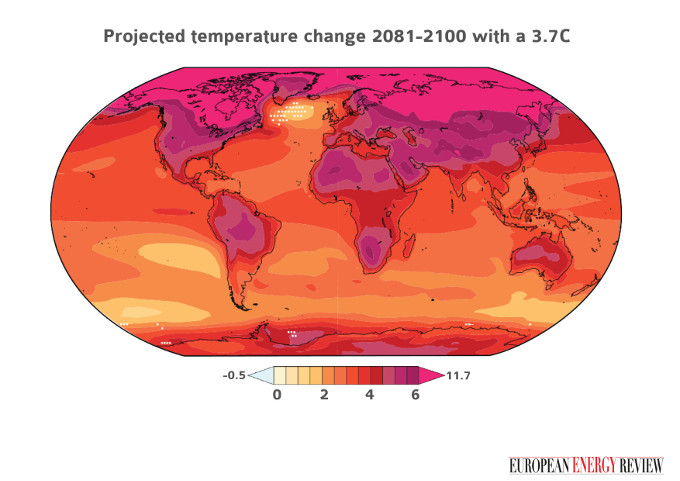
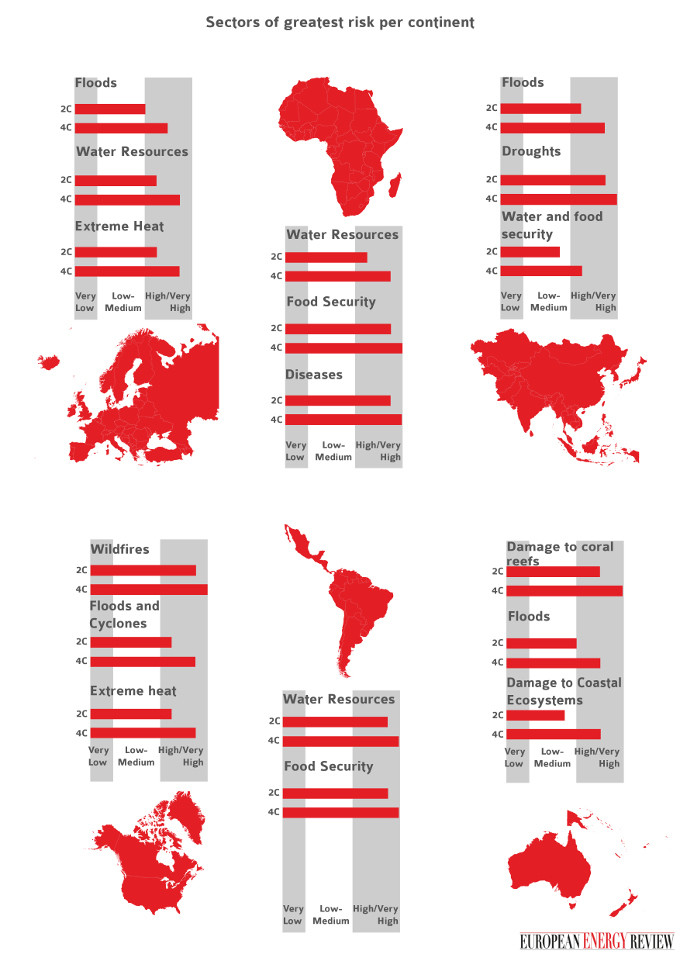
Source: IPCC.
In the autumn of 2014, NASA released a video to the scientific community, on which the Goddard Space Flight Center’s Global Modeling and Assimilation Office had been working for years and which portrayed A year in the life of Earth’s CO2. Two aspects strike the most: the significantly higher amount of CO2 generated in the Northern Hemisphere, and how fast this travels. It is a good demonstration of how climate change is a global issue we are facing, and how responsibility is shared but not evenly distributed. Emitters such as China did not enter the global stage before the 1950s, while others, the UK and Germany for example, are witnessing the decrease of their contribution to global emissions. Despite being the world's top emitter, China has however some time before catching up with the European historic cumulative level of emissions, 25% of total CO2 emitted from 1850 to 2011, or with the US, 27%, compared to 11% for the Chinese. Despite a fourfold increase, Chinese per capita emissions are still well below those of the US, all factors which will make establishing a common ground of discussion in Paris harder.
The uneven distribution of emissions is also a sectoral matter: even if transport is a clearly visible source of emissions, energy retains the largest share of emissions, and this strictly correlates with levels of national consumption and growth. Coal is still the resource responsible for the largest amount of emissions, a fact that is worrying considering the 19 coal plants still under construction in Europe, or the 26% decline of the European price for coal in 2015. Nonetheless, it should be remarked that emissions come from several different sources, and that two countries were solely responsible for almost half of global CO2 release from land use and forestry: Indonesia and Brazil.
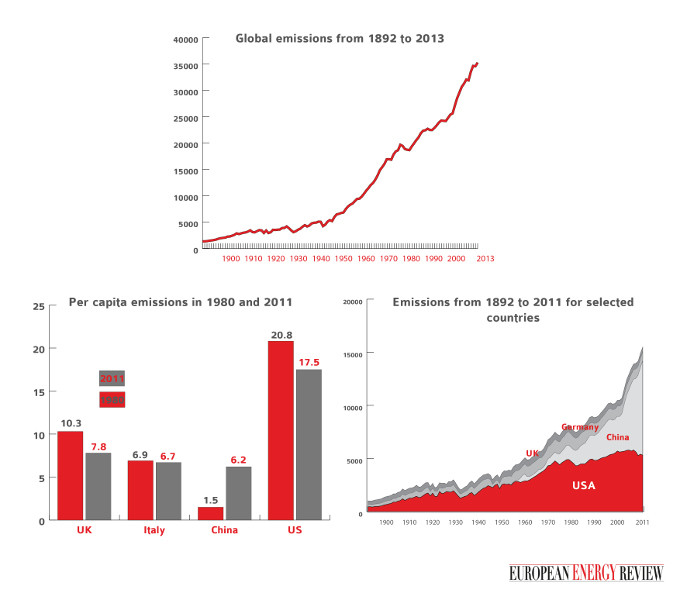
Units of measure: top: thousand metric tons of carbon; bottom left: metric tons per capita; bottom right: thousnad metric tons of carbon.
Source: EU, World Bank and CDIAC.
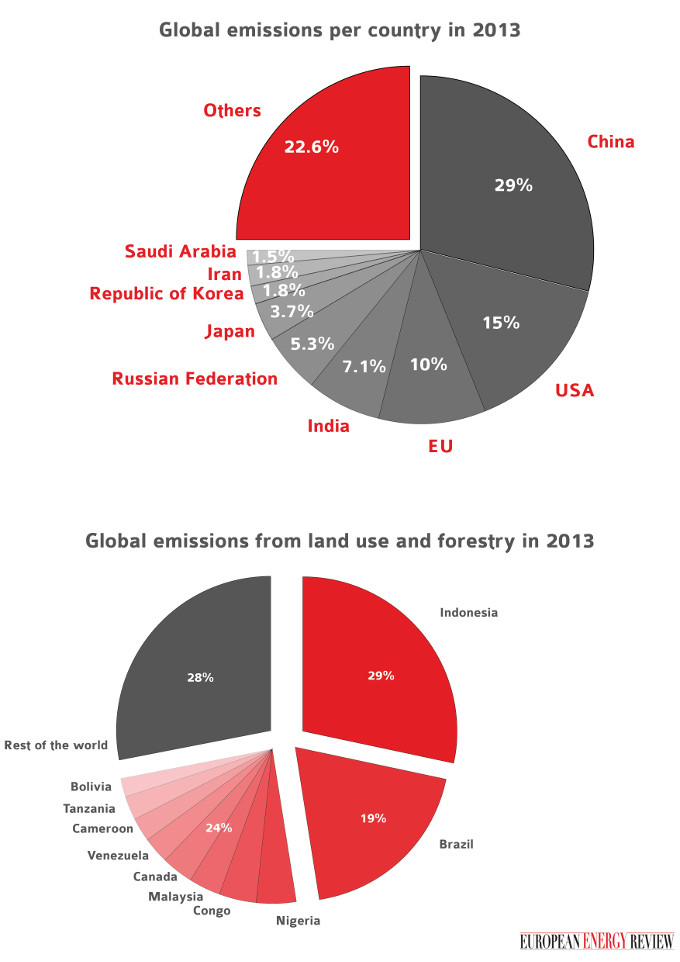
Source: CDIAC and World Resource Institute.

Source: World Resource Institute.
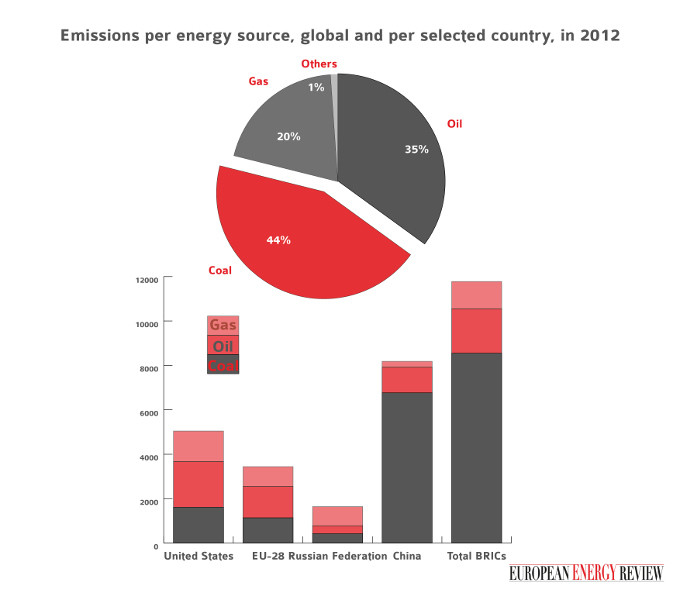
Source: EIA.
Source: Google Trends.
When comparing the number of Google searches for “climate change” to words such as “pope”, “Greece”, “crisis” and “immigration”, the first is constantly below the others, at least for the period 01/2014-09/2015. Similar results appear when comparing to “Syria” or “Middle East”. The result is not surprising: public awareness on climate change has significantly increased only from the early 1990s, and in these twenty years it also faced the disinterest of many national and international institutions and several deception campaigns, such as those disclosed by the Union of Concerned Scientists in July 2015. However, it is also true that climate change is an issue which is not easily addressed by humans, particularly from an ethical point of view. Researchers, such as professor Dale Jamieson from NYC University, suggested that the unclear consequences of the phenomenon, together with distributive concerns, makes it hard to judge the associated responsibility, and so to define who is required to act. More direct threats are often seen as more pressing issues, as the long term reasoning behind the idea of climate change is harder to grasp intuitively.
Results are often curious: climate skepticism is mostly concentrated in the Anglophone world, while BRICs, Brazil and China mostly, appear to be significantly aware of the anthropogenic origin of climate change. An attitude which is not simply shown in the surveys, but also in Google searches again: among some of the most climate related phrases googled on the web, “if there is global warming, why is it so cold?” or “is global warming real?” come from cities in the UK (London) or in the US (New York). Countries which, despite having a greater number of Google users, still rank low in relation to climate change-related searches, in particular when compared to countries such as Ethiopia or the Philippines.
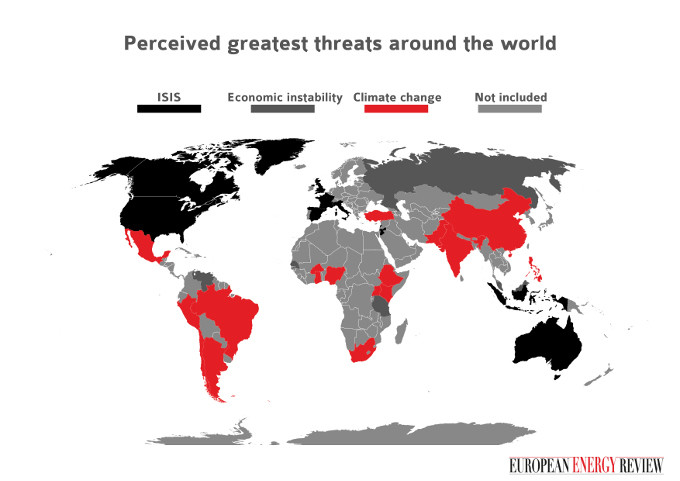
Source: Pew Center Survey, 2015.
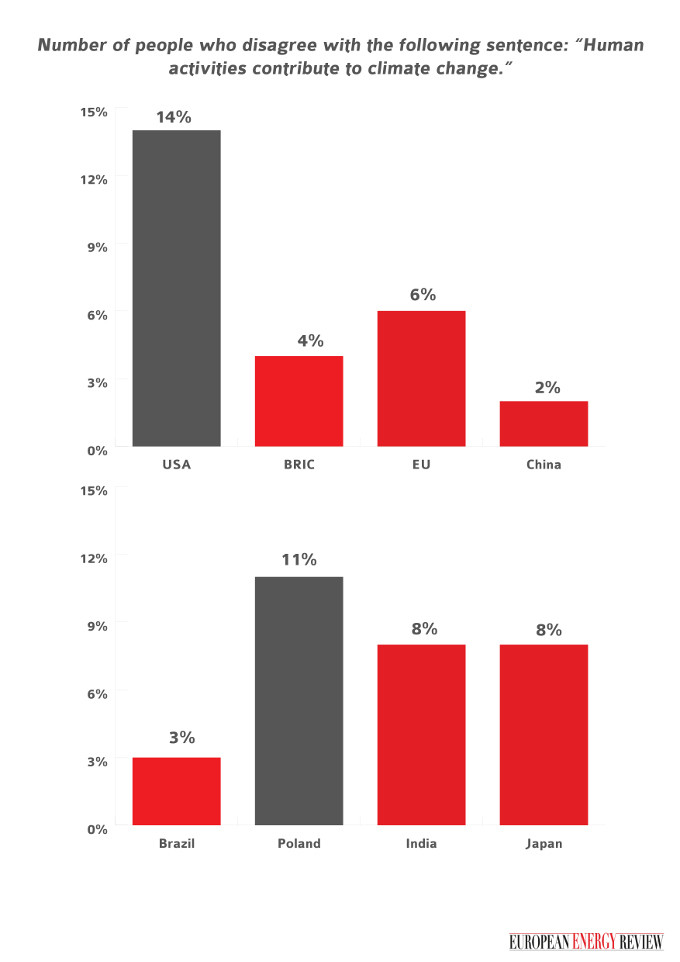
Source: Chatham House Survey via the Carbon Brief, 2014.

Source: Google Trends.
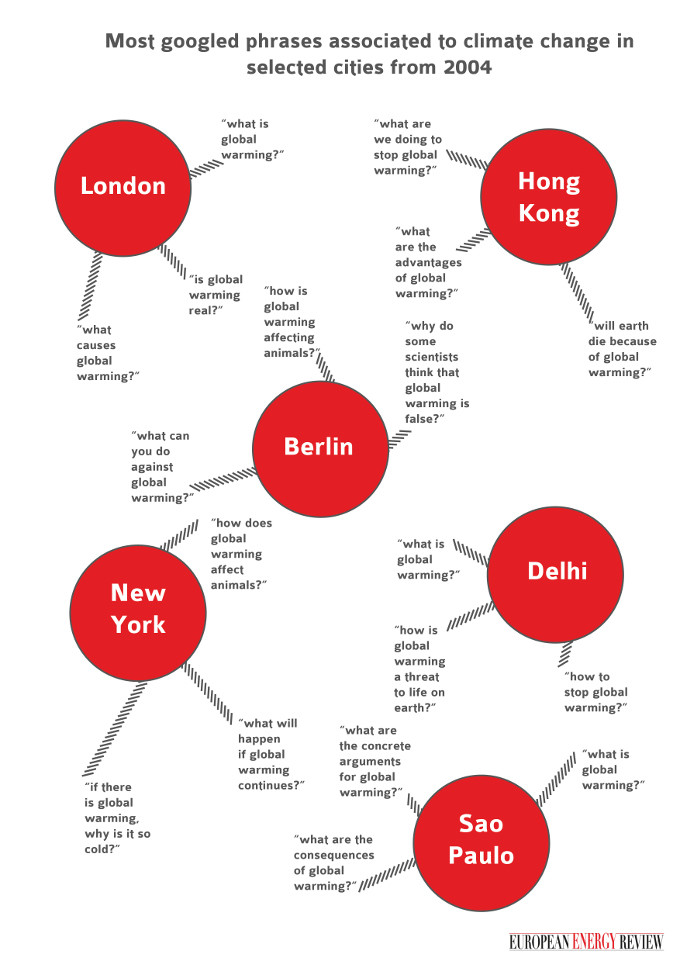
Source: Google Lab News.
Commitment by international governments is probably the most complicated part in the discussion over climate change. On the one hand, the situation has changed over the years: from the failure of the Kyoto Protocol and the several inconclusive COP of the early 2000s, many countries have moved towards pro climate positions. China and the USA have committed to a reduction in emissions and so did Japan, in particular after the meeting between the Japanese Prime Minister Shinzo Abe, President of the European Council Donald Tusk and President of the European Commission Jean-Claude Juncker. The loose deadline for Intended Nationally Determined Contributions (INDCs) for emission reduction last March was respected only by the EU and a few other countries, but several large emitters followed during the summer. However, many have not sent their contribution yet, and a thorough analysis of the INDC by Russia or the US offer a less optimistic view of the situation. Thanks to the decline of the heavy industry after the collapse of the Soviet Union, Russia’s INDC will not result in an actual reduction, but in a rather bland attempt to reduce the rise in emissions. A purpose which is also supported by the negative forecasts on the Russian economic growth for the next future.
Moreover, one of the greatest dangers is the lack of tools to put the emissions reduction targets into practice: while the EU has already a rather wide legislative package, others, such as the US, do not have such an equivalent apparatus. Lacking international climate finance, it is unclear how developing countries, often the most vulnerable, will be able to implement adaptation measures. The refusal by the Obama administration to support the 100 billion dollars fund for poor countries, established after Durban, is a good example of how theoretical commitment could be far from practice.
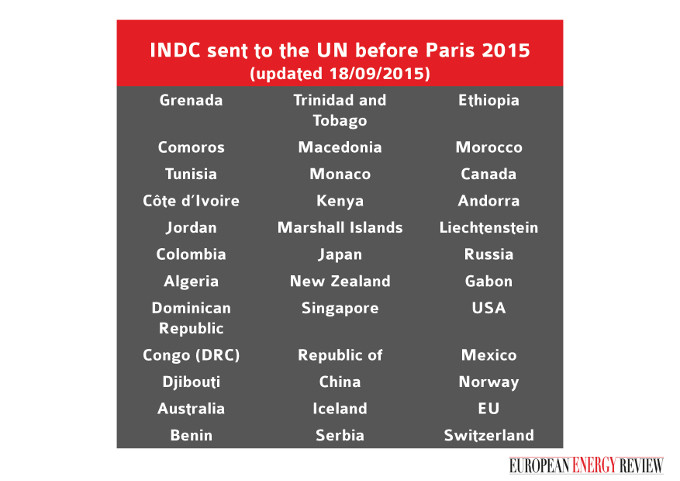
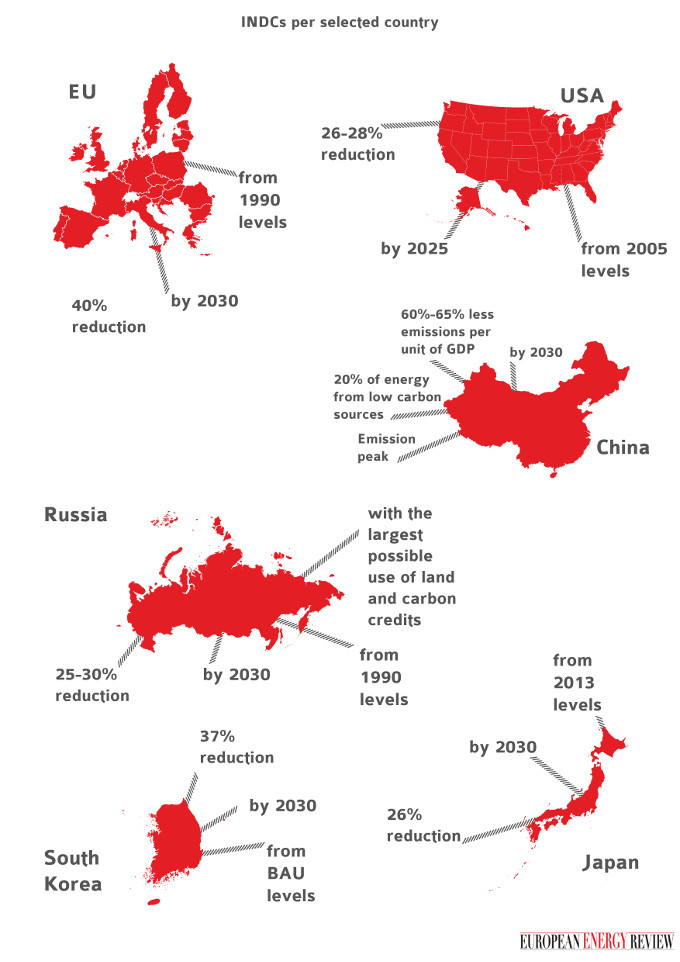
Source: UN.
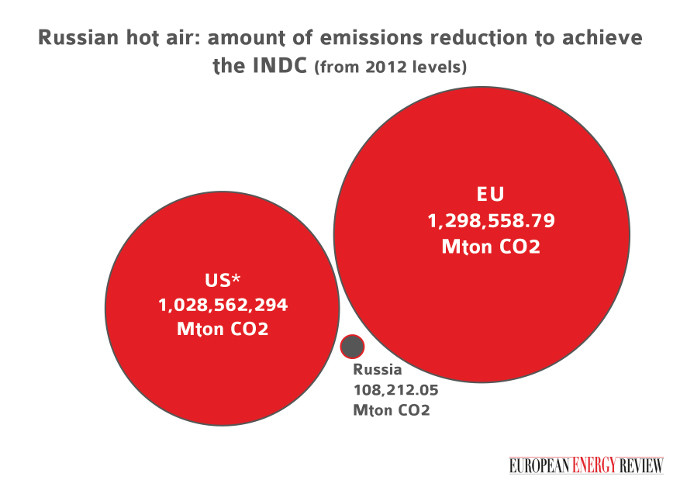
Source: Author’s calculations over EU data.
Source: Climate Action Tracker.
Under current levels of emissions and the INDCs, it is a fact that the 2C target will be largely missed. The IPCC estimates that, by 2045, we will have consumed our carbon budget, which is the maximum of allowed emissions before the temperature increase will exceed 2 degrees. The IEA forecast anticipates this to happen in 2040. A fact the IEA Executive Director, Faith Birol, has warned governments and private companies about several times, highlighting the economic costs of climate change. However, decreasing emissions will require changing a complex system involving ethics, attitudes, geopolitics, consumption and production, and which has strong inertia when it comes to the sector with the largest impact: energy. Energy investments require great amounts of resources and have a long time horizon, often several decades. Not surprisingly, the British decision to open new coal plants has received a worried reaction of OECD secretary general Angel Gurria, who fears the 500bn ton of CO2 they will emit at least until 2050. In the best case, the plants will have to be mothballed, becoming a stranded asset and a significant cost for the UK. In the worst option, they will, alone, consume half the carbon budget of the world. A budget which is coherent with the forecasts by McGlade and Paul Ekins, the two researchers who estimated the amount of unburnable fossil fuel reserves to keep the temperature below the 2C target, but incoherent with the current demand trends for fossil fuels.
If the above data, the estimates for the economic impact and the cost of stranded assets provide a number of good reasons to act on climate change, even more significant are those not mentioned in this article, those not possible to know yet. Climate change is an issue which holds a high degree of uncertainty: while it is possible to estimate the damages of a higher temperature, it is still unclear how and how much the weather will change. The reflection capacity of oceans, the heat absorption of snow and ice and, in general, the impact of human activities on the Earth albedo (the reflecting power of a surface) are largely unknown. A recent report estimates there are eight times more trees in the world then previously estimated. If this seems good news, the uncertainty and variability of such evaluations casts doubts on the real value of global deforestation. We have little knowledge of the magnitude of the extreme weather events we will have to face in the following decades, but we know how devastating even the tiniest cyclone can be. Paradoxically, uncertainty is the weapon of climate deniers, but it should be the first argument to reduce emissions and accelerate the energy transition. Indeed, when facing a darkness which can hide an abyss, we should prepare for the fall, then rushing into it, hope to find solid ground.

Source: IEA World Energy Outlook 2014.
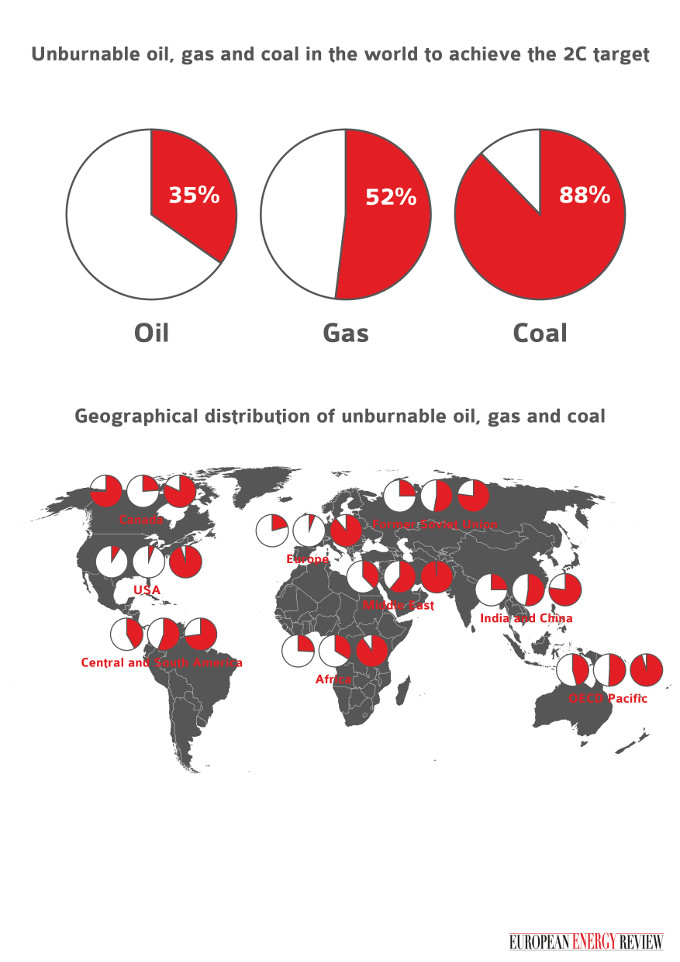
Source: McGlade and Paul Ekins.
Lorenzo Colantoni is a freelance journalist and researcher, specialised in energy and environment, particularly on European policies. He is Associate Fellow at the Istituto Affari Internazionali (IAI) in Rome, collaborating on a series of projects, the most prominent being the Energy Union Watch, based off of the recent initiative established by the European Commission.
As a journalist, he has worked with the geopolitical magazine Limes, particularly for the coordination of the October 2014 issue on the UK and Scottish separatism. In addition to the European Energy Review, he has been writing for L’Espresso, the Caspian Strategy Institute and the Energy Post, just to name a few outlets. @colanlo.
The concept of global warming was created by and for the Chinese in order to make U.S. manufacturing non-competitive.
— Donald J. Trump (@realDonaldTrump) 6 Novembre 2012
This very expensive GLOBAL WARMING bullshit has got to stop. Our planet is freezing, record low temps,and our GW scientists are stuck in ice
— Donald J. Trump (@realDonaldTrump) 2 Gennaio 2014
Meanwhile, climate deniers have been largely, and often secretly, funded by corporations. This is the case for Koch Industries, which are accused by Greenpeace of having spent almost $80 million on climate change denial since 1997, or Exxon Mobil, which funneled $16 million to deniers from 1998 to 2005. Similarly, media have often been criticised as biased, particularly for the disproportionate coverage of climate deniers, as in the 2014 accusations over the BBC reporting on the fifth IPCC report. An issue which the BBC itself already discussed in a 2011 report on science impartiality, which showed significant room for improvement. However, this goes in the opposite direction of the increasing scientific consensus: it was 2013 when Cook and others published a famous report which indicated a 97% consensus among scientists on the anthropogenic origin of climate change.
As the data are now more and more available, we decided then to summarise some of the most important, less heard and possibly useful pieces of evidence and facts on climate change.
Data are labelled under six mini chapters, which you can navigate by clicking on the links below.
1. Climate change evidence
2. Future impact of climate change
3. Causes and responsibility
4. Media coverage and the general public
5. National commitments and INDC
6. The future: trends and action
Source: NASA.
Temperatures have been clearly rising from 1977, but NASA data show that such a trend can be traced back even to the early 20th century. Climate scientists estimate that there is a 97% likelihood that 2015 will be the hottest year since records began in 1880, followed by 2014 and 2010, second and third. The ten warmest years have happened in the past 17 years, 9 of them in the 21st century.
This is not without consequences: higher temperatures are responsible for the fast decrease of the Arctic sea ice, which has been recorded since 1981, for the sea level rise and for the increased weather variability. Indeed, precipitation and heat extremes have significantly increased from pre-industrial age averages, up to five times. One of the most visible effects of climate change is, however, wildfires: compared to 35 years ago, higher temperatures and variable rain seasons have made forests more arid and more vulnerable, extending the average wildfire seasons in the US by more than a month. The dramatic California fires highlight the exposure of the USA, but this is global phenomenon which largely affects Asia and the Mediterranean, among the others.

Source: NASA and Fischer and Knutti.
Source: The Economist, the Lancet and the Stern Review.
The economic impact of climate change is still hard to define exactly, due to the uncertainty and the extent of such an unprecedented phenomenon, but even the most cautious estimates are alarming. In 2006, the “Stern Review on the Economics of Climate Change” was one of the first, and probably the most ambitious report trying to assess the economic costs of a 5-6 degrees temperature rise. Since then, several reports have tried to go deeper into the threats to specific sectors, as in the case of “The Cost of the Inaction”, by the Economist Intelligence Unit. Under the report’s assumptions, a 6C increase could lead the world to lose one third of its entire stock of manageable assets. If direct damages will have mostly a local effect, indirect impacts will greatly endanger the global economy.
Climate change will not affect every country in the same way: one of the reasons why “climate change” is probably a more accurate expression than “global warming” is that the temperature will not increase globally in the same way, and that what we have to fear the most is the variability of weather. Considering also geographical differences, climate change will have different effects in each continent and in each region, often magnified by the inability to cope with disasters of several countries. Hence the IPCC highlighted the high flood risks in Africa, which could be greatly reduced if effective adaptation is implemented. In the same way, heat risks could be avoided by successful urban planning in Asia, as traditional indigenous knowledge practices could positively support food security in Central and South America.


Source: IPCC.
In the autumn of 2014, NASA released a video to the scientific community, on which the Goddard Space Flight Center’s Global Modeling and Assimilation Office had been working for years and which portrayed A year in the life of Earth’s CO2. Two aspects strike the most: the significantly higher amount of CO2 generated in the Northern Hemisphere, and how fast this travels. It is a good demonstration of how climate change is a global issue we are facing, and how responsibility is shared but not evenly distributed. Emitters such as China did not enter the global stage before the 1950s, while others, the UK and Germany for example, are witnessing the decrease of their contribution to global emissions. Despite being the world's top emitter, China has however some time before catching up with the European historic cumulative level of emissions, 25% of total CO2 emitted from 1850 to 2011, or with the US, 27%, compared to 11% for the Chinese. Despite a fourfold increase, Chinese per capita emissions are still well below those of the US, all factors which will make establishing a common ground of discussion in Paris harder.
The uneven distribution of emissions is also a sectoral matter: even if transport is a clearly visible source of emissions, energy retains the largest share of emissions, and this strictly correlates with levels of national consumption and growth. Coal is still the resource responsible for the largest amount of emissions, a fact that is worrying considering the 19 coal plants still under construction in Europe, or the 26% decline of the European price for coal in 2015. Nonetheless, it should be remarked that emissions come from several different sources, and that two countries were solely responsible for almost half of global CO2 release from land use and forestry: Indonesia and Brazil.

Units of measure: top: thousand metric tons of carbon; bottom left: metric tons per capita; bottom right: thousnad metric tons of carbon.
Source: EU, World Bank and CDIAC.

Source: CDIAC and World Resource Institute.

Source: World Resource Institute.

Source: EIA.
Source: Google Trends.
When comparing the number of Google searches for “climate change” to words such as “pope”, “Greece”, “crisis” and “immigration”, the first is constantly below the others, at least for the period 01/2014-09/2015. Similar results appear when comparing to “Syria” or “Middle East”. The result is not surprising: public awareness on climate change has significantly increased only from the early 1990s, and in these twenty years it also faced the disinterest of many national and international institutions and several deception campaigns, such as those disclosed by the Union of Concerned Scientists in July 2015. However, it is also true that climate change is an issue which is not easily addressed by humans, particularly from an ethical point of view. Researchers, such as professor Dale Jamieson from NYC University, suggested that the unclear consequences of the phenomenon, together with distributive concerns, makes it hard to judge the associated responsibility, and so to define who is required to act. More direct threats are often seen as more pressing issues, as the long term reasoning behind the idea of climate change is harder to grasp intuitively.
Results are often curious: climate skepticism is mostly concentrated in the Anglophone world, while BRICs, Brazil and China mostly, appear to be significantly aware of the anthropogenic origin of climate change. An attitude which is not simply shown in the surveys, but also in Google searches again: among some of the most climate related phrases googled on the web, “if there is global warming, why is it so cold?” or “is global warming real?” come from cities in the UK (London) or in the US (New York). Countries which, despite having a greater number of Google users, still rank low in relation to climate change-related searches, in particular when compared to countries such as Ethiopia or the Philippines.

Source: Pew Center Survey, 2015.

Source: Chatham House Survey via the Carbon Brief, 2014.

Source: Google Trends.

Source: Google Lab News.
Commitment by international governments is probably the most complicated part in the discussion over climate change. On the one hand, the situation has changed over the years: from the failure of the Kyoto Protocol and the several inconclusive COP of the early 2000s, many countries have moved towards pro climate positions. China and the USA have committed to a reduction in emissions and so did Japan, in particular after the meeting between the Japanese Prime Minister Shinzo Abe, President of the European Council Donald Tusk and President of the European Commission Jean-Claude Juncker. The loose deadline for Intended Nationally Determined Contributions (INDCs) for emission reduction last March was respected only by the EU and a few other countries, but several large emitters followed during the summer. However, many have not sent their contribution yet, and a thorough analysis of the INDC by Russia or the US offer a less optimistic view of the situation. Thanks to the decline of the heavy industry after the collapse of the Soviet Union, Russia’s INDC will not result in an actual reduction, but in a rather bland attempt to reduce the rise in emissions. A purpose which is also supported by the negative forecasts on the Russian economic growth for the next future.
Moreover, one of the greatest dangers is the lack of tools to put the emissions reduction targets into practice: while the EU has already a rather wide legislative package, others, such as the US, do not have such an equivalent apparatus. Lacking international climate finance, it is unclear how developing countries, often the most vulnerable, will be able to implement adaptation measures. The refusal by the Obama administration to support the 100 billion dollars fund for poor countries, established after Durban, is a good example of how theoretical commitment could be far from practice.


Source: UN.

Source: Author’s calculations over EU data.
Source: Climate Action Tracker.
Under current levels of emissions and the INDCs, it is a fact that the 2C target will be largely missed. The IPCC estimates that, by 2045, we will have consumed our carbon budget, which is the maximum of allowed emissions before the temperature increase will exceed 2 degrees. The IEA forecast anticipates this to happen in 2040. A fact the IEA Executive Director, Faith Birol, has warned governments and private companies about several times, highlighting the economic costs of climate change. However, decreasing emissions will require changing a complex system involving ethics, attitudes, geopolitics, consumption and production, and which has strong inertia when it comes to the sector with the largest impact: energy. Energy investments require great amounts of resources and have a long time horizon, often several decades. Not surprisingly, the British decision to open new coal plants has received a worried reaction of OECD secretary general Angel Gurria, who fears the 500bn ton of CO2 they will emit at least until 2050. In the best case, the plants will have to be mothballed, becoming a stranded asset and a significant cost for the UK. In the worst option, they will, alone, consume half the carbon budget of the world. A budget which is coherent with the forecasts by McGlade and Paul Ekins, the two researchers who estimated the amount of unburnable fossil fuel reserves to keep the temperature below the 2C target, but incoherent with the current demand trends for fossil fuels.
If the above data, the estimates for the economic impact and the cost of stranded assets provide a number of good reasons to act on climate change, even more significant are those not mentioned in this article, those not possible to know yet. Climate change is an issue which holds a high degree of uncertainty: while it is possible to estimate the damages of a higher temperature, it is still unclear how and how much the weather will change. The reflection capacity of oceans, the heat absorption of snow and ice and, in general, the impact of human activities on the Earth albedo (the reflecting power of a surface) are largely unknown. A recent report estimates there are eight times more trees in the world then previously estimated. If this seems good news, the uncertainty and variability of such evaluations casts doubts on the real value of global deforestation. We have little knowledge of the magnitude of the extreme weather events we will have to face in the following decades, but we know how devastating even the tiniest cyclone can be. Paradoxically, uncertainty is the weapon of climate deniers, but it should be the first argument to reduce emissions and accelerate the energy transition. Indeed, when facing a darkness which can hide an abyss, we should prepare for the fall, then rushing into it, hope to find solid ground.

Source: IEA World Energy Outlook 2014.

Source: McGlade and Paul Ekins.
Lorenzo Colantoni is a freelance journalist and researcher, specialised in energy and environment, particularly on European policies. He is Associate Fellow at the Istituto Affari Internazionali (IAI) in Rome, collaborating on a series of projects, the most prominent being the Energy Union Watch, based off of the recent initiative established by the European Commission.
As a journalist, he has worked with the geopolitical magazine Limes, particularly for the coordination of the October 2014 issue on the UK and Scottish separatism. In addition to the European Energy Review, he has been writing for L’Espresso, the Caspian Strategy Institute and the Energy Post, just to name a few outlets. @colanlo.
Read full article
Hide full article


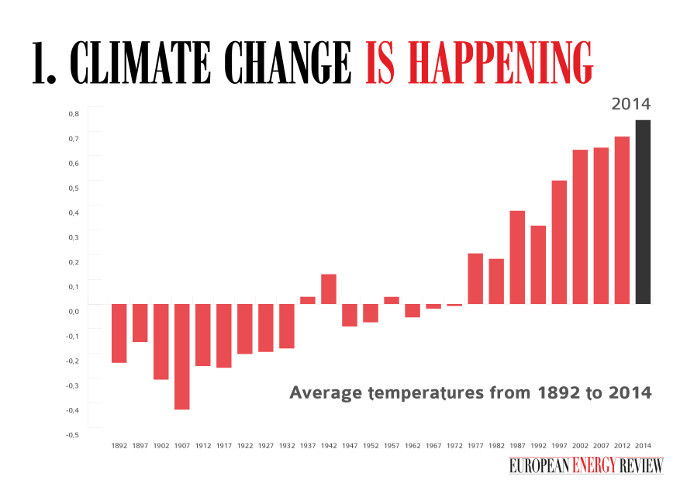
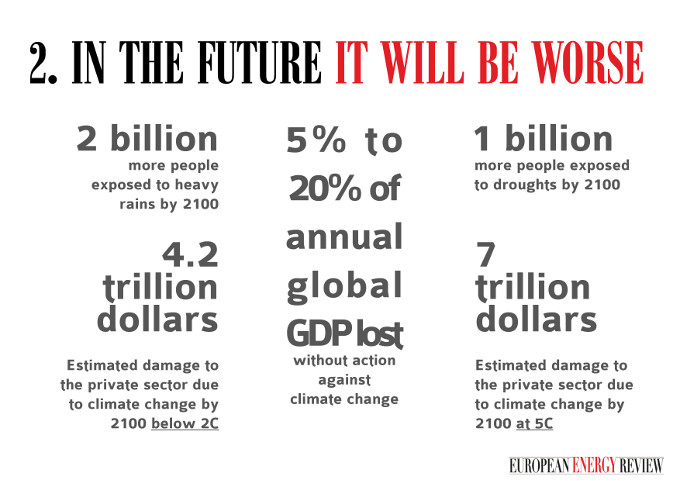
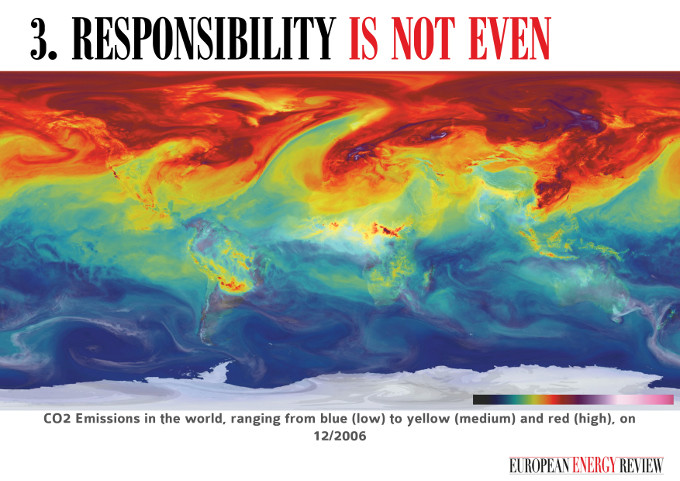
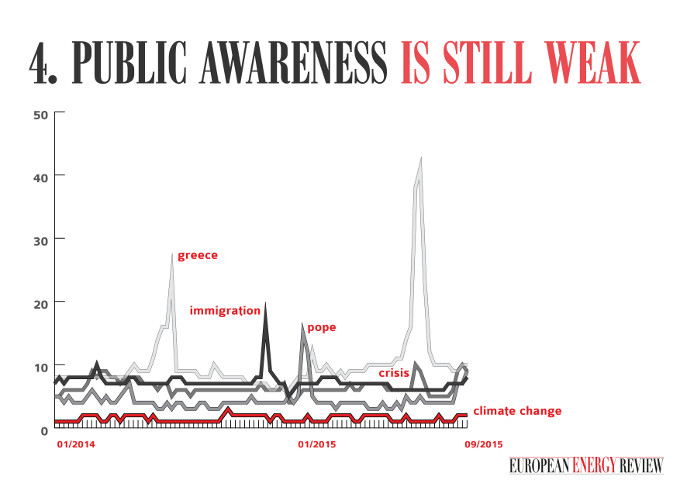

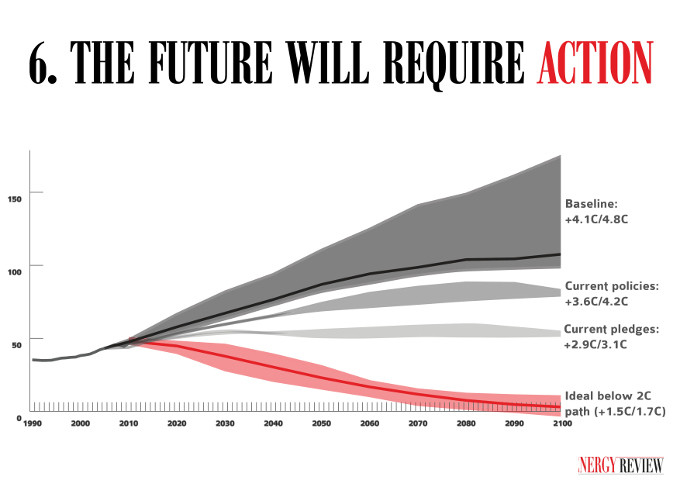
Discussion (0 comments)